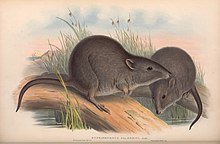Gilbert's potoroo
| Gilbert's potoroo | |
|---|---|
 |
|
| Scientific classification | |
| Kingdom: | Animalia |
| Phylum: | Chordata |
| Class: | Mammalia |
| Infraclass: | Marsupialia |
| Order: | Diprotodontia |
| Family: | Potoroidae |
| Genus: | Potorous |
| Species: | P. gilbertii |
| Binomial name | |
|
Potorous gilbertii Gould, 1841 |
|
 |
|
| Gilbert's potoroo range | |
Gilbert's potoroo (Potorous gilbertii), sometimes called the "rat-kangaroo" or "garlgyte", is Australia's most endangered marsupial and one of the world's most endangered mammals. It is a small nocturnal marsupial which lives in small groups or colonies. It has long hind feet and front feet with curved claws which it uses to dig for food. Its body has large amounts of fur which helps with insulation, and its fur ranges between brown and grey; the color fading on its belly. This potoroo has a long, thin snout curving downward that it uses to smell its surroundings; this trait is common in all potoroo species. Its eyes appear to bulge out of its face and look as though they are on an angle and its ears are almost invisible, buried under thick fur. Male and female body types are very similar and are both within the same size range. Adult females range in weight from 708–1205 g (including pouch young where present), whereas adult males range in weight from 845–1200 g.
The current estimated population is a sparse seventy individuals. It was thought to be extinct until its rediscovery in 1994. The only naturally located population is found in Two Peoples Bay Nature Reserve in Western Australia, where they co-exist with quokkas. Small populations are also being established at Bald Island and Michaelmas Island.
Gilbert's potoroo was first discovered in 1840 and named in 1841 after the English naturalist and explorer John Gilbert. Gilbert had collected several specimens at King George Sound in Australia, this potoroo being one of them. Gilbert's potoroo was not seen again for many years, even after a thorough search in the 1970s.
The species was considered extinct for 20 years before it was rediscovered in 1994 in Two Peoples Bay Nature Reserve. Liz Sinclair had been doing research on wallabies and caught the potoroo in one of her traps. She then compared her captured specimen with the skeletons of past potoroos and proved it was indeed a Gilbert's potoroo.
Gilbert's potoroo was once widespread throughout south-west Australia, including the areas around King George Sound and near the Margaret River, but now is found only on the Mount Gardner headland at Two Peoples Bay. Within that area of less than 1,000 hectares, the species occupies four separate patches of long, unburnt, dense shrubland on the valley slopes. These areas are described as Melaleuca striata and Melaleuca uncinata shrubland, between 1.5 and 2.0 m tall with 70-100% canopy cover, and a dense layer of sedges including Lepidosperma sp. and Anarthria scabra beneath. The vegetation forming its habitat has not been burnt for over 50 years, so long, unburnt areas are thought to be necessary for the species. It is nocturnal and spends its days hiding in the dense thicket, rarely crossing open large areas.
...
Wikipedia

